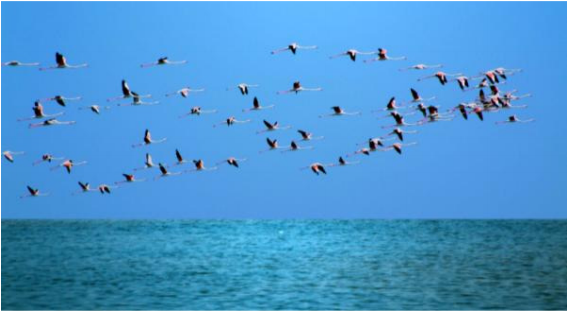Chilika
Additional information may please be sent as messages to the |
Contents |
Chilika
Queen of natural beauty, Chilika, the largest brackish water lake in Asia covering an area of over 1,100 sq. km is a great attraction for the tourists for fishing, bird watching and boating. In winter Chilika aflutters with thousands of indigenous and migratory birds of many varieties from far and near - even from the distant Siberia. The fabulous beauty of Chilika which has inspired poets to sing its glory and which can be best enjoyed from Balugaon, Barkul, Rambha and Satpada must be seen to be believed. One can also have a glimpse of the lake from the moving trains and vehicles on the road near these places. The atmosphere is just serene and undisturbed amidst the blue expanse of water on one side and an evergreen range of hills on the other. Dotted with a host of islands with romantic names, a cruise in Chilika will be a life-long memory.
Places of tourist interest in Chilika
Kalijai Island, Honeymoon Island, Breakfast Island, Birds Island, Nalabana (Island of Reeds), Parikud Island, etc. are some of the important and interesting spots inside the lake.
The Island of Kalijai is famous as a center of religious worship due to the temple of Goddess Kalijai where a big fair is held on the occasion of Makara Sankranti that falls in January every year. The Island of Nalabana, 8 km in circumference occupies a unique place in the vast expanse of Chilika Lake as it happens to be the central point for the migratory birds. One can view the dolphins at Chilika mouth near Satpara.
Best time to visit
August to March.
By Air - The nearest airport is at Bhubaneswar, 98 kms. from Balugaon, 105 kms from Barkul and , 130 kms from Rambha, 108 kms from Satapada.
By Rail - The nearest railhead is at Balugaon for Barkul (6kms), Puri for Satapada (50kms). Rambha is also a railhead. Bhubaneswar is yet another convenient railhead for visiting Chilika Lake.
By Road - Barkul,Balugoan and Rambha are situated on National Highway No.5. Regular buses ply between Berhampur and Bhubaneswar, which stop at Rambha and Balugoan. Tourists can avail of auto rickshaws and taxi from both these places and reach the lake in a short while.
The Lake can also be enjoyed from Satpada, 50 kms. from Puri. Regular bus service and also conducted tour service from Puri to Satapada is available.
Birds
2017 census: small drop in numbers: 8.9 lakh
Chilika Lake sees a marginal drop of birds at 8.9 lakh, January 4, 2018: The Hindu
Annual bird census was conducted by 21 teams
Bird population at the scenic Chilika Lake – Asia’s largest brackish water lagoon – has recorded a marginal drop from 9.4 lakh birds in 2017 to 8.9 lakh during winters in 2017-18.
After a day-long annual bird census, the bird count in Chilika came to 8,93,390, categorised in 147 species, said sources in the Forest and Environment department on Wednesday. Of the total estimated birds, 8,67,834 were found to be waterfowl of 95 different species and 25,556 water dependent of 52 species.
Dolphins also spotted
In 2017, the bird population was 9,47,119 of 167 species (9,24,353 waterfowl of 100 species and 22,766 water dependent of 67 species). The Nalabana Bird Sanctuary inside the Chilika has hosted 3,20,826 birds this year compared to 3,74,757 last year. Sources said river lapwing was sighted for the first time in the Chilika. Some dolphins were also spotted in the new areas.
Twenty-one census teams comprising Forest department personnel, wildlife enthusiasts, bird watchers and students had spread out on vast waters of the lake on Wednesday. According to the Chilika Development Authority (CDA), clear sky and favourable weather helped estimating the number of birds.
“This year, we were apprehending that there could be fall in number of migratory birds flocking the Chilika. However, we had a good monsoon that ensured vast mudflats remained under water for considerable period of time,” said Sushant Nanda, CDA Chief Executive.
Migratory birds fly across continents from the Caspian Sea, the Baikal Lake and remote parts of Russia, Mongolia and Siberia and come to marshy lands of the Nalabana Bird Sanctuary inside the Chilika Lake which is spread across over 1,000 sq km. They find adequate preys in shape of small fishes and insects in the mudflats.
In order to showcase arrival of large number of migratory birds to wetlands of Odisha, the State government had announced to organise a national bird festival this year. It is intended at promoting bird-watching in the State.
Apart from Chilika, bird census was conducted in major wetlands of the Bhitarkanika National Park and the Similipal National Park.
